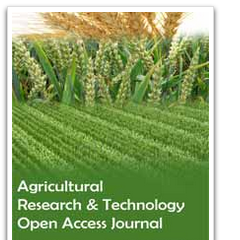Agricultural Research & Technology - Juniper Publishers
Abstract
TIn the light of recent assessment of greenhouse gas emissions and global impact on climate change, transition from conventional to more sustainable agriculture is of prior importance. Farmers have already experienced alternative crop management practices and their respective impact on climate change is widely studied. However, a lot of investigation still needs to be done, notably concerning the long-term impact of the combined practices. This communication puts the light on management of crop residuals degradation dynamics and its impact on cropland soil respiration.
Keywords: Crop residuals; Carbon sequestration; sustainable agroecosystems; Global policies; Lower greenhouse; Croplands and farms; Conservation agriculture; Soil profile; Soil bulk density; Climate change
Croplands and Transition to Sustainable Agroecosystems
TGlobal policies encourage to lower greenhouse gas emissions in order to maintain climate change under the limit of +2°C at the horizon 2100. An important part of these gases are emitted from croplands and farms [1]. To reduce the environmental impact of croplands, diverse techniques and practices have been widely used by farmers, based on conservation agriculture (simplified cultivation techniques, cover-cropping, agroforestry, etc.). The use of these techniques has been adopted freely, according to the good will of farmers. Scientists have broadly studied these crop management practices in order to evaluate their impact on climate change [2–4]. Actual assessment of carbon emissions and storage capacities of croplands under such crop management practices had helped us to discriminate the practices useful for carbon accumulation. No-tillage has an important role to play in agriculture, mainly because of the great impact on soil bulk density and ease of crop germination. However, it is now well known and admitted that no-till have no significant impact alone on soil carbon storage capacities over the entire soil profile [5]. Cover-cropping is also an interesting and promising management practice to consider when accounting for climate resilient agroecosystems, soil carbon sequestration [6] and ecosystem services [7]. This practice can have very contrasted impacts on soil and the agroecosystem depending on sowing and destruction period, species used, for how long and how the residues are managed. Indeed, cover-cropping leads to improved biomass production and undoubtedly, to more crop residues. The impact of crop residues on soil carbon have been widely studied [8–10], but their impact on soil respiration still needs to be clarified. How do cover crop residues respiration change over the crop season? Soil respiration was measured with an infrared portable gas analyzer together with a soil respiration chamber (EGM4 and SRC1, PP Systems, Amesbury, USA). The study site was located in Southwest France (N 43° 24’ 38.057’’, E 0° 17’ 17.612’’, alt= 266 m) on a soil defined as a Stagnic Luvisol according to the World Reference Base for Soil Resource [11]. No-till and cover-cropping have been implemented for 20 years, which improved soil organic carbon content of 48.8% compared to conventional agricultural system. The cover crop was mainly composed of faba bean (Vicia faba), oat (Avena sativa) and triticale (×Triticosecale) for the last 4 years. We measured soil respiration with and without residues and for residues alone. We observed an increase of soil residues respiration over the season as well as of values dispersion (Figure 1). Very low level of respiration rate was observed from the 30th of June to the 10th of September, even if few points had respiration values in the range of values generally observed for soil respiration for temperate ecosystems [12]. But significant higher values of respiration were observed on the 29th of September and October (p value < 0.05). The increase in soil respiration across the season was attributed to the maturation of crop residues and their gradual transformation from fresh organic matter to labile and dissolved organic matter, more easily degradable for microorganisms. It then appeared that the degradation process of cover crops passed through different phases; slow degradation until the senescence of the cash crop (here maize), then degradation inducing significant respiration. It seems that maize senescence leaded to favorable conditions for cover crop residuals degradation. Usually, when maize enters senescence, farmers stop irrigation to let maize dry before harvesting. Cover crop residuals could reach their optimum degradation rate with optimum both soil moisture and temperature promoting respiration of residuals in this particular time period. A second hypothesis is that maize plants senescence could imply microorganisms within maize rhizosphere to look for other sustainable carbon source when maize roots stop to diffuse exudates in soil [13,14]. These microorganisms could change of substrate when maize exudates stop and move from exudates to surface carbon.
Conclusion
TCover-crops constitutes a good solution to improve soil carbon content sequestration, both by increasing biological activities notably through biomass accumulation and exudation, and abiotic impact on cropland (temperature and humidity control). However, the production of supplementary biomass induces supplementary carbon fluxes from the agroecosystems that needs to be taken into account when assessing carbon footprint of croplands.

To Know more about Agricultural Research & Technology
Click here: https://juniperpublishers.com/index.php





No comments:
Post a Comment